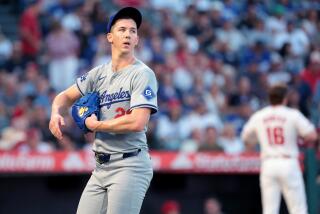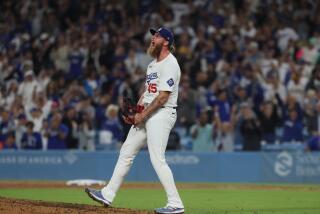Dodgers and Rockies take different approaches to building a better bullpen
- Share via
The Colorado Rockies have not been subtle about their winter game plan: dramatically improving their bullpen in order to challenge the Dodgers in the National League West.
If your intuition says that makes sense because Coors Field is such a miserable place to pitch that the Rockies have to fill many more relief innings than the Dodgers do, well, your intuition would be wrong.
The Dodgers’ bullpen pitched more innings than the Rockies’ bullpen last season.
That was more a product of the Dodgers’ design than the Rockies’ struggles. The Dodgers kept their starters on a tight leash, generally preferring to rest them on the 10-day disabled list rather than extend them into the seventh inning. The one starter they did trust with the seventh inning, Clayton Kershaw, was on the disabled list for five weeks because of a back injury.
The Dodgers trust their approach, so a deep and talented bullpen is vital to their success. Their bullpen had the best earned-run average in the league last season.
The Dodgers also do not believe that long-term investments in setup men are prudent — too many years and too much guaranteed money for pitchers whose performances can tend to fluctuate over the years.
In 2016, they got a nice year out of Joe Blanton, who had transitioned to relief the previous year, and Grant Dayton, who was targeted for the high spin rate on his pitches. In 2017, they rode Brandon Morrow, who had signed a minor league contract and shed his “oft-injured” label long enough to enjoy a dominant season.
That brings us to 2018. The Dodgers have filled two bullpen holes this winter, neither with a brand-name reliever. They added Tom Koehler, whom they believe can be like Blanton — a mediocre starter turned excellent reliever. And, on Thursday, they added Scott Alexander, an unheralded ground-ball specialist.
They are expected to pay Koehler and Alexander less than $3 million combined. Morrow got $21 million from the Cubs, and they can worry about whether he can stay healthy for two more years.
For the Dodgers, it is not as much about saving money per se as it is about believing in their analytical ability to identify cost-effective relievers, and preserving the financial flexibility to go get other arms if the analytics do not translate to on-field success.
The Rockies have opted for proven success. They have guaranteed $106 million this winter to three relievers: closer Wade Davis and setup men Jake McGee and Bryan Shaw.
In 2018, they will pay at least $7 million to each of five relievers: Davis, McGee, Shaw, Mike Dunn and Adam Ottavino. (They can afford this in part because they figure to pay no more than a combined $5 million to their five projected starters.)
The Dodgers’ projected bullpen options, with plenty of winter left to add more: closer Kenley Jansen, Alexander, Koehler, Pedro Baez, Tony Cingrani, Josh Fields, Yimi Garcia, Adam Liberatore and Ross Stripling.
How the Dodgers and Rockies bullpens fare will go a long way toward determining how much ground Colorado can make up in the NL West. The Rockies finished 17 games behind the Dodgers last season.
In mid-December, after the Rockies signed McGee and Shaw, general manager Jeff Bridich was asked whether the Colorado roster was good enough to win the World Series.
“Yes,” Bridich said, according to the Denver Post.
Two weeks later, the Rockies signed Davis.
Follow Bill Shaikin on Twitter @BillShaikin
More to Read
Go beyond the scoreboard
Get the latest on L.A.'s teams in the daily Sports Report newsletter.
You may occasionally receive promotional content from the Los Angeles Times.











